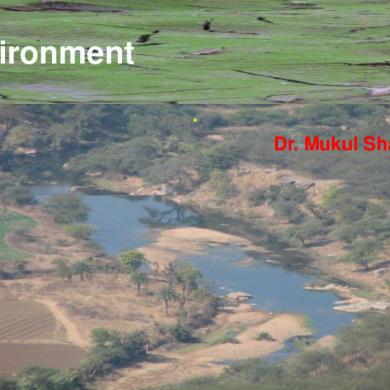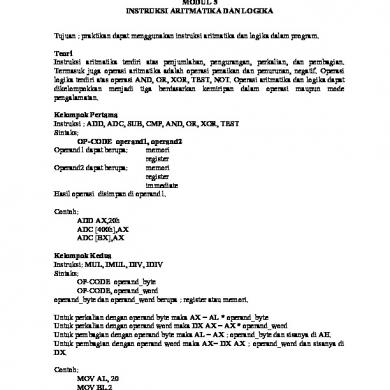Lecture Three Vedic Religion
This document was uploaded by user and they confirmed that they have the permission to share it. If you are author or own the copyright of this book, please report to us by using this DMCA report form. Report DMCA
Overview
Download & View Lecture Three Vedic Religion as PDF for free.
More details
- Words: 792
- Pages: 28
Loading documents preview...
The Vedas & Vedic Religion Prof. Jessica Vantine Birkenholtz RLST 110 3 September 2015
Today
2
Devi
The Vedas & Vedic religion
Key concepts/teachings
Dharma
Karma, samsara, moksha
Atman, Brahman
Devi
Mahadevi = Great Goddess
3
5th c CE
Two dominant categories:
‘Mild’: Lakshmi, Parvati, Saraswati, Sita, Radha
‘Wild’: Durga, Kali
Shakti
Saraswati
4
Associated with speech, learning, culture, and wisdom
Consort: Brahma
Lakshmi
5
Associated with prosperity, well being, royal power, and illustriousness
Consort: Vishnu
Parvati
Consort: Shiva
6
Two sons: Ganesh and Kumar
Parvati and Shiva
7
Tension between householder and ascetic ideals
Parvati’s role
Shiva-Shakti
Durga
8
Virgin warrior goddess
Fierce and destructive, but working for the good of the cosmos
Role reversals
Kali
9
Fierce virgin warrior goddess
Blood-thirsty demon-slayer
All-loving, compassionate Mother
Krishna & Radha
Lengthiest and most individualized biography
10
Historical hero and god
The Divine as human
Love affair with Radha
Celebrations of the Divine
Rituals
Fasting
Festivals
Pilgrimage
Procession s
Sacrifice
11
National, regional, village level
Hinduism: Now and Then
Brhadaranyaka Upanishad, 3.9.13.9.9
12
How many?
Chronology of Hinduism
Indus valley civilization (c. 2500 to 1500 BCE)
Vedic period (c. 1500 to 500 BCE)
13
Rise of Aryan culture
The Vedas and dharma, and ritual texts composed
Epic and puranic period (c. 500 BCE to 500 CE)
Composition of Mahabharata and Ramayana
Composition of Puranas
Vaisnavism, Saivism, and Saktism begin to develop
Chronology of Hinduism
14
Medieval period (c. 500 CE to 1500 CE)
Development of bhakti tradition
Continued development of Vaishnavism, Shaivism, and Shaktism
Sanskrit and vernacular devotional literature and poetry; tantric literature
Modern period (c. 1500 CE to the present)
Rise and fall of Mughal and British Empires
Origin of India as a nation state
“For Hinduism, the meaning of ‘tradition’ is cumulative, not unchanging.” (Hawley & Narayanan, Life of Hinduism, 4)
15
The Vedic World
c. 1500 to 500 BCE
Aryans, the ‘noble ones’
Vedas
Vedic religion and society
The Vedas
Composed 1500 BCE to 500 BCE
“Book of knowledge”
Shruti, ‘that which was heard’
Oral tradition
17
Rshis (seers, sages)
Brahmans
The Vedas
18
Samhitas (collections)
Rg veda
Sama veda
Yajur veda
Atharva veda
Brahmanas (instructions for performance of rituals)
Aranyakas (forest treatises)
Upanishads (secret treatises) -philosophical
Vedic Gods
The Rg veda
The Devas (gods)
19
Many related to natural phenomena
Dyaus (sky)
Varuna (night)
Vayu (wind)
Agni (fire)
Soma (moon and soma plant)
Usha
Vayu
Main Devas
No supreme deity in the Rig Veda
Three prominent deities:
Agni
Soma
Indra
Agni
20
Indra
King of the gods
Warrior deity
21
Thunderbolt
Rig Veda 1.32
Triumph over Vritra
Releasing the waters
Rta
Comic order
Power of rta = highest power
22
Not even the gods can go against it
Varuna’s domain
“A unifying principle [that] kept the individual, social, ritual, and the cosmic orders in harmony”
Vedic Religion
23
Rites of sacrifice
Hymns, fire, soma
Power of hymns & flawless performance of ritual
Propitiation of gods
Relationship b/w men and gods
Maintaining cosmic order
Vedic Society
Purusha Sukta, ‘Hymn to the Supreme Person’ (Rig Veda 10.90)
Origins of the four classes (varnas)
Brahmin (priests, scholars)
Kshyatriya (warriors, kings, royal/ruling families)
Vaishya (merchants, peasants, agriculturalists, artisans)
Shudra (servants)
24
Untouchables (dalits, harijans)
Vedic to Vedantic
Upanishads
25
Vedanta, 600 to 300 BCE
Discuss several important philosophical ideas that are central to later Hinduism
Karma
Samsara
Moksha
Atman
Brahman
Karma, Samsara, & Moksha
Karma = action, especially ritual action
26
Cause and effect
Samsara = a continuing cycle of death and rebirth, i.e., reincarnation
Moksha = spiritual liberation and personal salvation
• Brhadaranyaka Upanishad 4.4.1- 4.4.7
Atman & Brahman
27
Atman = human soul
Brahman = Supreme Being, Ultimate Reality
Pervades and transcends human thought and the universe
Cannot describe it
Review
Aryans
Vedas
Rig Veda
Upanishads
Vedic religion
Ritual/sacrifice, fire, hymns
Agni, Soma, Indra
Dharma Karma Samsara Moksha Atman Brahman
Vedic society
Four varnas
28
• • • • • •
Brahmins, kshyatriyas, vaishyas, shudras
Today
2
Devi
The Vedas & Vedic religion
Key concepts/teachings
Dharma
Karma, samsara, moksha
Atman, Brahman
Devi
Mahadevi = Great Goddess
3
5th c CE
Two dominant categories:
‘Mild’: Lakshmi, Parvati, Saraswati, Sita, Radha
‘Wild’: Durga, Kali
Shakti
Saraswati
4
Associated with speech, learning, culture, and wisdom
Consort: Brahma
Lakshmi
5
Associated with prosperity, well being, royal power, and illustriousness
Consort: Vishnu
Parvati
Consort: Shiva
6
Two sons: Ganesh and Kumar
Parvati and Shiva
7
Tension between householder and ascetic ideals
Parvati’s role
Shiva-Shakti
Durga
8
Virgin warrior goddess
Fierce and destructive, but working for the good of the cosmos
Role reversals
Kali
9
Fierce virgin warrior goddess
Blood-thirsty demon-slayer
All-loving, compassionate Mother
Krishna & Radha
Lengthiest and most individualized biography
10
Historical hero and god
The Divine as human
Love affair with Radha
Celebrations of the Divine
Rituals
Fasting
Festivals
Pilgrimage
Procession s
Sacrifice
11
National, regional, village level
Hinduism: Now and Then
Brhadaranyaka Upanishad, 3.9.13.9.9
12
How many?
Chronology of Hinduism
Indus valley civilization (c. 2500 to 1500 BCE)
Vedic period (c. 1500 to 500 BCE)
13
Rise of Aryan culture
The Vedas and dharma, and ritual texts composed
Epic and puranic period (c. 500 BCE to 500 CE)
Composition of Mahabharata and Ramayana
Composition of Puranas
Vaisnavism, Saivism, and Saktism begin to develop
Chronology of Hinduism
14
Medieval period (c. 500 CE to 1500 CE)
Development of bhakti tradition
Continued development of Vaishnavism, Shaivism, and Shaktism
Sanskrit and vernacular devotional literature and poetry; tantric literature
Modern period (c. 1500 CE to the present)
Rise and fall of Mughal and British Empires
Origin of India as a nation state
“For Hinduism, the meaning of ‘tradition’ is cumulative, not unchanging.” (Hawley & Narayanan, Life of Hinduism, 4)
15
The Vedic World
c. 1500 to 500 BCE
Aryans, the ‘noble ones’
Vedas
Vedic religion and society
The Vedas
Composed 1500 BCE to 500 BCE
“Book of knowledge”
Shruti, ‘that which was heard’
Oral tradition
17
Rshis (seers, sages)
Brahmans
The Vedas
18
Samhitas (collections)
Rg veda
Sama veda
Yajur veda
Atharva veda
Brahmanas (instructions for performance of rituals)
Aranyakas (forest treatises)
Upanishads (secret treatises) -philosophical
Vedic Gods
The Rg veda
The Devas (gods)
19
Many related to natural phenomena
Dyaus (sky)
Varuna (night)
Vayu (wind)
Agni (fire)
Soma (moon and soma plant)
Usha
Vayu
Main Devas
No supreme deity in the Rig Veda
Three prominent deities:
Agni
Soma
Indra
Agni
20
Indra
King of the gods
Warrior deity
21
Thunderbolt
Rig Veda 1.32
Triumph over Vritra
Releasing the waters
Rta
Comic order
Power of rta = highest power
22
Not even the gods can go against it
Varuna’s domain
“A unifying principle [that] kept the individual, social, ritual, and the cosmic orders in harmony”
Vedic Religion
23
Rites of sacrifice
Hymns, fire, soma
Power of hymns & flawless performance of ritual
Propitiation of gods
Relationship b/w men and gods
Maintaining cosmic order
Vedic Society
Purusha Sukta, ‘Hymn to the Supreme Person’ (Rig Veda 10.90)
Origins of the four classes (varnas)
Brahmin (priests, scholars)
Kshyatriya (warriors, kings, royal/ruling families)
Vaishya (merchants, peasants, agriculturalists, artisans)
Shudra (servants)
24
Untouchables (dalits, harijans)
Vedic to Vedantic
Upanishads
25
Vedanta, 600 to 300 BCE
Discuss several important philosophical ideas that are central to later Hinduism
Karma
Samsara
Moksha
Atman
Brahman
Karma, Samsara, & Moksha
Karma = action, especially ritual action
26
Cause and effect
Samsara = a continuing cycle of death and rebirth, i.e., reincarnation
Moksha = spiritual liberation and personal salvation
• Brhadaranyaka Upanishad 4.4.1- 4.4.7
Atman & Brahman
27
Atman = human soul
Brahman = Supreme Being, Ultimate Reality
Pervades and transcends human thought and the universe
Cannot describe it
Review
Aryans
Vedas
Rig Veda
Upanishads
Vedic religion
Ritual/sacrifice, fire, hymns
Agni, Soma, Indra
Dharma Karma Samsara Moksha Atman Brahman
Vedic society
Four varnas
28
• • • • • •
Brahmins, kshyatriyas, vaishyas, shudras
Related Documents

Lecture Three Vedic Religion
February 2021 1
Literary Criticism Lecture Two& Three
January 2021 1
Lecture Two & Three Classical Criticism Aristotle
January 2021 1
Vedic 1
January 2021 5
Vedic Numerology
January 2021 2
Lecture
February 2021 3More Documents from "Aashique Rock"

1.modul 5 Operasi Aritmatika Dan Logika
February 2021 0
Digital.photography.tricks.and.tips.2nd.ed.2020
March 2021 0
Wcm Overview Training
January 2021 1
English For Information Technology & Teleccomunications
January 2021 1
Singen_im_advent_-_auflage_3.pdf
February 2021 0